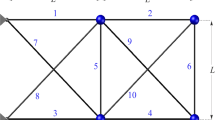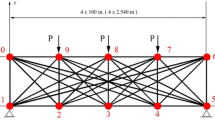Abstract
In this work, the input for large space structures is created using the Formex algebra of the Formian software. The different search and optimisation algorithm known as evolution strategies (ESs) has been applied to find the optimal design of the space trusses considering the areas of the members of the space structures as discrete variables. The objective function is obtained for first few generations by using a structural analysis package such as Feast and for other generations by functional networks (FNs). Initially, to obtain the data for a functional network, a structural package such as Feast is used. The use of a functional network is motivated by time consuming repeated analyses required by evolution strategies during the optimisation process. In addition, a multilevel optimisation approach is implemented by reducing the size of the search space for individual design variables in each successive level of the optimisation process for the first example; for the remaining three examples, a functional network has been combined with evolution strategies to get away with the use of a structural analysis package and a multilevel optimisation technique. The numerical tests presented demonstrate the computational advantage of the proposed approach of ESs combined with functional networks (FNs) which become pronounced for fairly large scale optimisation problems involving about 700 degrees of freedom.











Similar content being viewed by others
References
Nooshin H (1984) Formex configuration processing in structural engineering. Elsevier Applied Science Publications, London
Nooshin H (2001) Formex configuration processing I. Int J Spac Struct 15(1):1–52
Nooshin H (2002) Formex configuration processing II. Int J Spac Struct 16(1):1–56
Nooshin H (2002) Formex configuration processing III. Int J Spac Struct 17(1):1–50
Anonymous (1995) FEAST User Manual, SEG, SDS Group, ISRO, VSSC, Trivandrum, India
Castillo E (1998) Functional networks, Neur Proc Lett 7:151–159
Castillo E, Cobo A, Gutierrez E, Pruneda E (1998) An introduction to functional networks with applications. Kluwer, Boston, MA
Castillo E, Cobo A, Manuel J, Gutierrez E, Pruneda E (2000) Functional netwoks: a new network based methodology. Comp Aid Civ Infra Eng 15:90–106
Castillo E, Gutierrez JM, Cobo A, Castillo C.(2000) Some learning methods in functional networks. Comp Aid Civ Infra Eng 1:427–439
Rajeev S, Krishnamoorthy CS (1992) Discrete optimization of structures using genetic algorithms. J Struct Eng ASCE 118(5):1233–1250
Erbatur F, Hasancebi O, Tutuncu I, Kitic H (2000) Optimal design of planar and space structures with genetic algorithms. Comp Struct 75:209-224
Rajasekaran S (2001) Optimization of large scale three-dimensional reticulated structures using cellular genetic and neural networks. Int J Spac Struct 16(4)
Saka MP (1990) Optimum design of pin-jointed steel structures with practical applications. J Struct Eng ASCE 116(10):2599–2620
Rechenberg I (1973) Evolution strategy: optimization of technical systems according to the principles of biological evolution. Frommann-Holzboog, Stuttgart (in German)
Schwefel HP (1981) Numerical optimization for computer models. Wiley, Chichester, UK
Joines J, Houck C (1994) On the use of non-stationary penalty functions to solve non-linear constrained optimization problems with GA. In: Michalewicz Z, Schaffer JD, Schwefel HP, Fogel DB, Kitano H (eds) Proceedings of the first IEEE Internatinal Conference on Evolutionary Computation. IEEE, Ann Arbor, MI
Coello, CA (2002) Theoretical and numerical constraint-handling techniques used with evolutionary algorithms: a survey of the state of the art. Comp Meth Appl Mech Eng 191:1245–1287
Papadrakakis M, Lagaros ND, Tsompanakis Y (1998) Structural optimization using evolution strategies and neural networks. Comp Meth Appl Mech Eng 156:309–333
Lagaros ND, Papadrakakis M, Kokossalakis G (2002) Structural optimization using evolutionary algorithms. Comp Struct 80:571–589
Papadrakakis M, Lagaros ND (2002) Reliability-based structural optimization using neural networks and Monte Carlo simulations. Comp Meth Appl Mech Eng 191:3491–3507
Cai J, Thierauf G (1993) Discrete structural optimization using evolution strategies. In: Topping BHV, Khan AI (eds) Neural networks and combinatorial in civil and structural engineering. Civil Comp, Edinburgh
Bishop CM (1995) Neural networks for pattern recognition. Oxford University Press, Oxford, UK
Rajasekaran S, Murray DW (1973) Incremental finite element matrices. J Struct Div ASCE (ST12)99:2423–2436
Rajasekaran S (2002) Stability checks. In: Ramaswamy GS, Eekhout M, Suresh GR (eds) Analysis, design and construction of steel space structures, Thomas Telford, UK
Annonymous (1995) STAD-III for Windows users manual, Research Engineers Pvt Ltd
Acknowledgements
The authors thank the management and the principal, Dr. S. Vijayarangan, of PSG College of Technology for providing the necessary facilities to carry out the research work reported in this paper. The authors thank the two anonymous reviewers for their comments that greatly helped them to improve the contents of the paper.
Author information
Authors and Affiliations
Corresponding author
Rights and permissions
About this article
Cite this article
Rajasekaran, S., Mohan, V.S. & Khamis, O. The optimisation of space structures using evolution strategies with functional networks. Engineering with Computers 20, 75–87 (2004). https://doi.org/10.1007/s00366-004-0268-4
Received:
Accepted:
Published:
Issue Date:
DOI: https://doi.org/10.1007/s00366-004-0268-4




